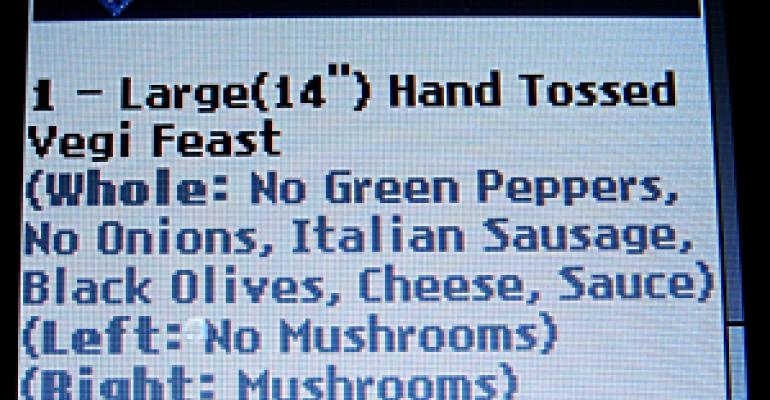ANN ARBOR Mich. Domino's Pizza, based here, says a Web-enabled cell phone ordering service using text messaging is boosting sales by a mid-single-digit amount at the approximately 2,700 U.S. restaurants now accepting such orders.
Domino's is currently in the midst of expanding the service initiated in September to an unspecified number of stores, according to Rob Weisberg, vice president of precision and print marketing for the chain with 5,128 U.S. units. Added Weisberg, "There will be a lot of activity in the coming months."
Meanwhile, Louisville, Ky.-based Papa John's earlier this month launched a text messaging order option at all 2,700 of its U.S. stores. And New York-based Mobo Systems Inc., which said it supports online and text-message ordering for about 200 restaurants through www.gomobo.com, this month unveiled GoEat, a "turnkey" service for chains that want to use Mobo's technology but brand it as their own.
Weisberg of Domino's said the number of individuals registering online to use the cell phone ordering service is comparable to the number registering to accept, or "opt-in" to receive, e-mail marketing messages from the chain. For order-confirmation purposes, users of the mobile ordering service must agree to accept text messages from Domino's, just as users of the online ordering system must agree to accept e-mail from the chain.
The mobile ordering service is in essence an enhancement to Domino's rollout of online ordering, which occurred earlier this year.
Weisberg said customers' reaction to the mobile ordering option has been "extremely positive," with consumer feedback indicating that users find the system easy to navigate. "We designed the service so that a person stopped at a red light could conceivably place an order via three or four quick clicks on a mobile device, then receive a delivery in 30 minutes," he explained.
To use the system, Web-enabled cell phone users log on to mobile.dominos.com and enter their choice of pizza, side items and soft drink, along with a delivery address. They also can enter their credit card information, if they wish.
The ordering process is simplified in part through what Weisberg deems a "sniffer" application developed for Domino's by Chicago-based HS2 Solutions. That technology streamlines the mobile.dominos.com interface, determining the make and model of the handset from which individual mobile orders are being placed. Based on this information, data at the site is adjusted automatically to accommodate the smaller shape of each mobile device as well as the particular shape of its screen, regardless of customers' carriers.
Also making the service easier to use is the fact that once on the site, consumers can enter their Domino's online ordering user name and password to retrieve all previous orders saved on the system. Such orders carry over to users' mobile devices, with the carry-over process covering any coupons associated with the order.
Once orders are placed, a "store locator" capability built into the sniffer application determines which unit should receive the orders, based on the address associated with the customers' mobile number. "We have very defined trade areas, and the store locator enables us to offer the service while being entirely fair to our franchisees," Weisberg explained. Orders simultaneously hit stores' point-of-sale systems — which run a homegrown program called Pulse — and their "make lines," where the orders appear on kitchen monitors.
Kitchen printers interfaced with the monitors generate slips containing order details, while at the same time, labels bearing customers' address and order information are produced at the point of sale and affixed to pizza boxes. Separate point-of-sale receipts for customers paying with credit cards also are created at this juncture.
Encrypting credit card data on the site, coupled with Pulse's PCI-compliant status, adds a safety net to the electronic payments process, Weisberg said.
Integrating the mobile ordering system with Pulse was a relatively straightforward process, because the latter was developed in an O/S programming language, said Weisberg, who noted, "It was really a 'plug-and-play' scenario." However, he said, Domino's did encounter some glitches during a rigorous months-long evaluation period that entailed placing "hundreds, if not thousands" of test orders from corporate headquarters.
"There were a few instances where errors in lines of code popped up somewhere along the ordering continuum, but they were rectified as we went along," Weisberg said.
The Papa John's mobile device ordering service requires users to register online to create accounts. They can save four favorite orders, along with the delivery address and payment preference. Users can select "FAV1," "FAV2," "FAV3" or "FAV4" to text message orders. Papa John's sends a reply, and customers have the option to change or confirm their orders.
In a written statement announcing the service, Papa John's chief executive Nigel Travis said, "Text ordering will allow us to reach a different group of customers who prefer text over online and email." The chain also will send promotions and advertisements to cell phone users who sign up for the text service, but users can choose to opt out of receiving the ads.

